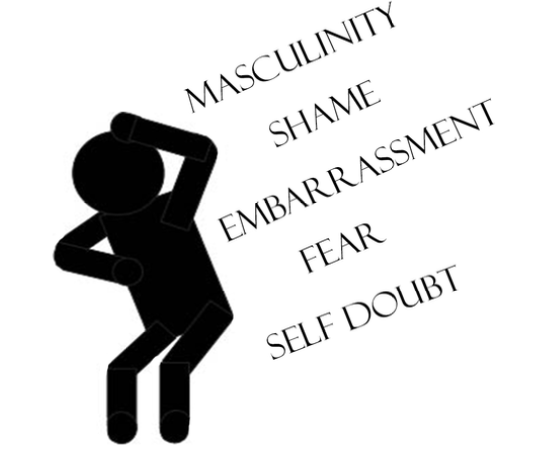
By Leanne Hamilton
Executive Editor
Imagine you are walking down the street hands tucked in your pockets when you notice a woman walking towards you. A bleeding nose, is shaking, and isn’t wearing appropriate clothing. Do you immediately take action and come to her aid and intervene? Do you immediately believe that she has been assaulted? Keep that in mind. Now imagine a man is walking toward you in the same condition:bleeding nose, shaking, and torn clothes. What is your reaction to him? Do you cross to the other side of the street? Do you think he’s gotten himself into a fight? Maybe you ask if you can help, but still keep your distance? Do you ever think he is fleeing from his partner, who has just assaulted him?

ILLUSTRATION BY LEANNE HAMILTON
For some men, the last scenario is real. According to the National Domestic Violence Hotline statistics, nearly 10 percent of men have experienced rape, physical violence, and/or stalking by their partner and have reported a related impact on their day-to-day function. Nearly half of all men and women in the U.S. have experienced psychological aggression by an intimate partner in their lifetime. Half of male victims (52.4 percent) reported being raped by an acquaintance and only 15.1 percent by a stranger. About 6 percent of men experience sexual coercion in their lifetime, while 11.7 percent of men experience unwanted sexual contact. I spoke with David O’Leary, a registered psychotherapist that has worked with cases of male domestic abuse, for some more information on this quiet epidemic. “The very idea in society that men could be abused in a relationship, the connotations in society, means men are far less likely to reach out for help or even admit to themselves what they’ve experienced,” said David O’Leary, a registered psychotherapist in Burlington who has worked with both men and women who have suffered from sexual abuse . “I’ve worked with maybe 570 women and about maybe 10 to 15 men. These ratios show that.”
The concept of masculinity within our society, the expectations of men around this concept of masculinity, definitely play a role in men’s hesitation to reach out, O’Leary said, explaining that he has often heard men talk about what is expected of them, about always having control, and defining their corner physically or mentally.
“What happens when you need to assert your power and control in a relationship that is asserting power/control over you?” O’Leary said. For men, that can be complicated by societal assumptions. If the abuser is a woman, it causes questions of doubt in the male partner. “Is this even happening? She’s a man I’m a woman, maybe she’s just having a bad day.”
Men who have reached out for help, have mentioned that they didn’t know where to go. “If we look at the language around domestic violence, it’s women helping battered women. In 2003, the Violence Against Women Act was established. A man searching for what to do next may find this language specific for women and find that they’re out of luck,” said O’Leary.
Changing the language can help to start the conversation that support is out there not only for women, but men as well. This conversation can be brought to campus as well, through different concepts and discussions within courses. “My initial reaction is that we talk about violence against women but there’s men that experience this too and it’s not really talked about, said Meg Schneider ‘22, a student registered in the Mena and Masculinity course at St. Michael’s College. “Showing the statistics, even if the numbers seem kind of low, it’s still enough to [show]that this does happen and is a problem.”
“We talk about toxic masculinity in class and what kind of culture that creates that men feel they need to be dominant,” explained Schneider. “If something like this were to happen to them it might make them feel weak. I think that makes them feel like ‘oh maybe I’m not masculine enough’ and not report it.”
Even if abuse of men has not been happening on campus, Schneider feels it should still be part of our campus conversation. “Obviously this happens and if this isn’t a conversation, no one is going to want to talk about it,” said Schneider. “I work with Active Minds and we have been trying to do something around men’s mental health and that could be a part of the conversation because topics like this affect mental health.”
Schneider added that the Violence Against Women Act, should be expanded to include men. “ it’s bad enough that someone should have to go through this, but it’s even worse when they feel there is no support out there for them.”
“I totally picture women right off the bat; women as the victim, men as the perpetrator” said Cierra Pierce ’20, r also taking the Men and Masculinity course. “In our class specifically we try to remember that men can be victims too. I think I would be surprised at first [to find the man is actually the victim] but then correct myself and think, “Yes, Cierra, men can be victims too.”
“Manning up and being tough, and not crying definitely keeps [men] from reaching out,” Pierce said.. “I don’t think masculinity should just be tough, emotionally closed off, don’t cry. If men actually have the capacity to be emotional and be vulnerable, to let themselves cry, I think that is more masculine because it takes more strength and more courage to be that vulnerable,” said Pierce.
The conversation of domestic abuse be it physical, sexual, or emotional, may be heavily geared towards female victims, but that doesn’t mean it can’t be shifted to include other perspectives such as males as the victim, or transgender people. Anyone can find themselves in a toxic relationship, some signs of abuse are more subtle than others. “Ask yourself, does it feel right? Do I feel I am always second in this relationship? Do I think less of myself because of this relationship? If you answer yes to most of these questions, you have recognized a pattern of what is not right and it’s time to reach out,” s O’Leary said. If you are unsure of what is abuse, check out the sidebar in the bottom right corner for some subtle signs you may not recognize.

